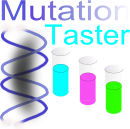 |
Mutation T@ster
Examples | |
Example 1 is a deletion that was found more than 4 times in the 1000Genomes Project (TGP) in homozygous state.
There is no amino acid exchange since the deletion lies within an intronic sequence. As it can be seen from the low
phyloP / phastCons values, the deleted bases are hardly conserved. The splice site changes should be
interpreted with care, especially in this context where the variant is not conserved and has been frequently
found homozygous in the TGP. It can be assumed that the splice site changes are false positive
predictions. The classification 'polymorphism' is due to the findings in the TGP but the
high probability indicates, that MutationTaster would have classified this variant as non-disease causing anyway.
Example 2 (disease mutation): CLDN16_G191R
This alteration is a single base exchange that is listed in NCBI ClinVar as a known disease-causing variant
(dbSNP:rs104893721) for HOMG3 (HYPOMAGNESEMIA 3, OMIM 603959#0003).
The altered base leads to an amino acid substitution at a highly conserved residue (amino acid is identical in all homologs).
Since the amino acid exchange is quite dramatic (a neutral glycine is replaced with a charged arginine),
the substitution has a high amino acid exchange score (3.41, extracted from the Grantham matrix).
As reflected by the high phyloP and phastCons scores, the position is also conserved on the DNA level. The predicted splice site changes are only marginal and can therefore be neglected. The classification 'disease causing' is due to the ClinVar entry but the high probability indicates, that MutationTaster would have classified this variant as disease causing anyway.
Example 3 (disease mutation): SOD1_H47R
Example 3 is a mutation that is listed in NCBI ClinVar as a known disease-causing variant (dbSNP:rs121912443) for ALS (AMYOTROPHIC LATERAL SCLEROSIS 1, OMIM 147450#0008).
The involved amino acid residue is highly conserved and lies within the catalytic copper-binding site of the protein, which is displayed as lost protein feature.
The phyloP and phastCons values for this position (4.283 and 0.996) are also very high, indicating strong evolutionary conservation. Again, the prediction is due to the ClinVar entry but has a very high probability anyway.
Example 4 (disease mutation): CHRND_L63P
This single base exchange in the CHRND gene is listed in NCBI ClinVar as a known disease-causing variant (dbSNP:rs121909508) for MYASTHENIC SYNDROME, CONGENITAL, FAST-CHANNEL, OMIM 100720#0013).
It results in an amino acid exchange from leucin to proline. The involved amino acid residue is part of a functional domain (topo domain) and is highly conserved (amino acids identical in all homologes). As a consequence of the mutation, the topo domain is lost. The phyloP and phastCons values for the changed nucleotide are very high, again indicating strong evolutionary conservation
The mutation is identical to the one in example 4 but this time, the query is submitted via the MutationTaster Chromosomal Positions interface. The analysis is therefore conducted for all available transcripts at the respective position and not just for a single transcript.
Contact
In case you discover bugs, have suggestions or questions, please write an e-mail to
Jana Marie Schwarz (jana-marie.schwarz AT charite.de) or to
Dominik Seelow (dominik.seelow AT charite.de).
We also appreciate hearing about your general experiences using MutationTaster.

